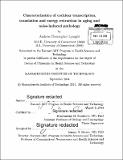| dc.contributor.advisor | Konstantina M. Stanković. | en_US |
| dc.contributor.author | Lysaght, Andrew Christopher | en_US |
| dc.contributor.other | Harvard--MIT Program in Health Sciences and Technology. | en_US |
| dc.date.accessioned | 2015-03-05T15:57:29Z | |
| dc.date.available | 2015-03-05T15:57:29Z | |
| dc.date.copyright | 2014 | en_US |
| dc.date.issued | 2014 | en_US |
| dc.identifier.uri | http://hdl.handle.net/1721.1/95864 | |
| dc.description | Thesis: Ph. D., Harvard-MIT Program in Health Sciences and Technology, 2014. | en_US |
| dc.description | Cataloged from PDF version of thesis. | en_US |
| dc.description | Includes bibliographical references (pages 147-163). | en_US |
| dc.description.abstract | Success in otologic practice is currently limited by the diagnostic tools and treatment options available to address an individual's specific presentation of hearing loss. This limitation results from insufficient characterization of the inner ear's biochemical environment as well as physical hurdles associated with accessing inner ear tissues. The encapsulation of the hearing organ within a bony shell and delicate nature of its tissues make standard tissue biopsy techniques impossible and leave many imaging methods impractical. This thesis sought to approach these clinical limitations in two ways: (1) performing novel transcriptional and translational characterizations of inner ear tissues and (2) development of a novel technique to access and communicate diagnostic information from within the inner ear. The first part of this thesis employs whole transcriptome shotgun sequencing to study murine inner ear transcriptional activity in young, healthy animals as well as changes associated with organ aging and noise-induced auditory neuropathy, an important mechanism of hearing impairment in humans. Knowledge of the inner ear's transcriptional behavior (Part I) is coupled with novel translational insights provided by high-throughput tandem mass-spectrometry (Part III) studies of human inner ear fluids obtained from healthy and pathologic populations. These studies illuminate homeostatic mechanisms employed by the highly specialized inner ear tissues, providing a critical knowledge-base for inner ear scientists and pharmacologists, and identify important expression-level changes which occur during the onset and progression of inner ear pathologies. While these high-throughput studies offer the powerful ability to gain a wealth of knowledge into which genes are active within the inner ear, functional assessment of the specific role these genes play must be assessed in a more focused manner. Phenotypic characterization of mice with specific genetic mutations (Part II) has been performed to provide critical insight into the specific role Fgf23 plays in development and maintenance of the auditory system. The second arm of this thesis seeks to provide clinical practicality to the above work by developing a method to safely access the inner ear environment to gather and communicate diagnostic information (Part IV). A guinea pig model was utilized to develop an approach to insert microelectrodes into the fluid spaces of the inner ear in order to harness and monitor the natural electrochemical gradient of the organ. The useful energy extracted from this "biological battery" was used to power a combined microchip/radio transmitter capable of performing voltage-sensing operations within endolymph and wirelessly relaying this information to an external receiver. This study was the first to utilize a mammalian electrochemical potential to power an electronic device. By performing this task while preserving the integrity of the hearing organ this work provides the first, critical proof-of-concept demonstration toward clinically-applicable sensing and therapeutic devices powered by the inner ear. Further refinement of this technique into a long-term, fully-implantable device will enable previously impossible longitudinal studies of organ behavior in awake, behaving subjects and the incorporation of sensing modalities into current inner ear prostheses to monitor biochemical changes and maximize patient benefits. | en_US |
| dc.description.statementofresponsibility | by Andrew Christopher Lysaght. | en_US |
| dc.format.extent | 163 pages | en_US |
| dc.language.iso | eng | en_US |
| dc.publisher | Massachusetts Institute of Technology | en_US |
| dc.rights | M.I.T. theses are protected by copyright. They may be viewed from this source for any purpose, but reproduction or distribution in any format is prohibited without written permission. See provided URL for inquiries about permission. | en_US |
| dc.rights.uri | http://dspace.mit.edu/handle/1721.1/7582 | en_US |
| dc.subject | Harvard--MIT Program in Health Sciences and Technology. | en_US |
| dc.title | Characterization of cochlear transcription, translation and energy extraction in aging and noise-induced pathology | en_US |
| dc.type | Thesis | en_US |
| dc.description.degree | Ph. D. | en_US |
| dc.contributor.department | Harvard University--MIT Division of Health Sciences and Technology | |
| dc.identifier.oclc | 904050905 | en_US |
